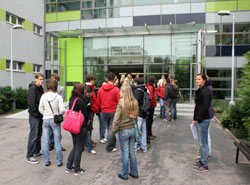Faculty of Medicine
 The medical curriculum at the Third Faculty of Medicine uses a modern approach to teaching medicine, placing particular emphasis on the integration of the related fields to help students gain a better understanding of the healthcare sector. Students are introduced to practical and clinical medicine from very early on and, therefore, come into contact with patients from the first year of the degree programme.
The medical curriculum at the Third Faculty of Medicine uses a modern approach to teaching medicine, placing particular emphasis on the integration of the related fields to help students gain a better understanding of the healthcare sector. Students are introduced to practical and clinical medicine from very early on and, therefore, come into contact with patients from the first year of the degree programme.
The six-year degree programme is split into three cycles which, in turn, are further divided into modules and courses. The first cycle focuses on basic medical sciences, the aim of which is for students to understand the inner workings of the human mind and body. The second cycle focuses on pre-clinical subjects and the third cycle deals with clinical work.
The first year includes two large modules and two small ones. The “Cell” module teaches students about cells and tissues, their components, metabolic pathways and the different ways in which they relate to health and disease, and ends with an exam at the end of the year (the first major exam of the degree programme). The “Patient” module aims to develop students’ communication skills, basic nursing skills and medical ethics, and provides them with their first face-to-face contact with patients. The “Biophysics” course provides students with an understanding of medical physics, introducing them to basic radiology physics, nuclear medicine, other diagnostic and therapeutic methods and information technology. The “Medical Terminology” course teaches students to talk like a doctor, with a particular focus on Latin and Greek words. “Structure and Functions of the Human Body” is a second-year course that builds on the knowledge acquired in the “Cell” module. It looks at tissues and organs – their structure, spatial relationships and functions – and ends with a final exam at the end of the second year.
In order to complete a course or module, students have to attend lectures, submit the necessary work, sit assessment examinations and pass the final exam. Each individual course has its own specific requirements, which can be found in the Student Information System. We recommend you check the requirements for all courses at the start of the academic year in order to plan your time effectively and avoid any last-minute surprises.
Course structure
Cycle I (Year 1– 2: Basic Biomedical Sciences) – Head: Prof. MUDr. Josef Stingl, CSc.
Module A: Structure and Functions of Human Body
Module B: Cell Biology and Genetics
Module C: Biophysics and Informatics
Module D: Needs of the Patient
Module E: Methodology
Separate courses: Medical Terminology (Latin), Summer Practice in Nursing Course.
Cycle II (Year 3 – 4: Principles of Clinical Medicine) – Head: Prof. MUDr. Jiří Horák, CSc.
Module A: Theoretical Foundations of Clinical Medicine
Module B: Introduction to Clinical Examination
Module C: Clinical and Pathological Foundations of Medicine
Module D: Elective Courses or Student Research Activity
Separate courses: Czech Language – Communication with Patients, Medical Psychology and Pathopsychology, Summer Practice in Internal Medicine, Summer Practice in Surgery.
Cycle III (Year 5 – 6: Clinical Preparation) – Head: Prof. MUDr. Michal Anděl, CSc.
Module of Internal Medicine Module of Surgery
Module of Neurobehavioral Sciences
Module of Obstetrics and Gynecology
Module of Pediatrics
Module of Preventive and Primary Care
Separate courses: Otorhinolaryngology, Ophthalmology, Dermatovenerology, Forensic Medicine, Emergency Medicine, Infection & Geographic Medicine, Summer Practice in an Elective Discipline (or in General Practice), Summer Practice in Obstetrics and Gynecology.






